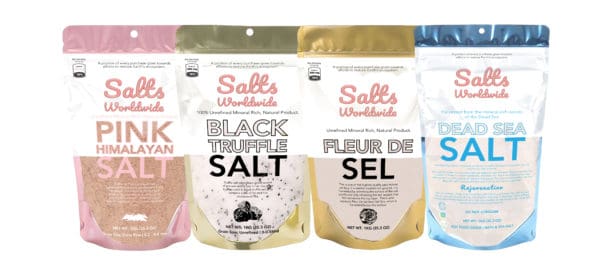
We all know the importance of salt, but how do you know which salts are best for your diet? Here are some examples: Flakes of sea salt, Fleur de sel, Himalayan pink salt, Brittany gray, and many more. In addition to their health benefits, these salts are also beautiful and make a great addition to any dish. Read on to learn more about the differences between these salts.
Flakes of sea salt
Maldon sea salt flakes are a favourite among shoppers and chefs alike. The soft, flaky texture of Maldon sea salt makes for an incredibly clean flavour, without the aftertaste of bitterness. All natural foods are boosted by the addition of this delicious salt. To find out more about Maldon sea salt, read our article about its benefits. We hope you enjoy the benefits of this sea salt and choose it for your next meal!
Flakes of sea salt are made from the pyramid-shaped crystals that float on the surface of the sea. They are expensive and time-consuming to produce. Most popular producers of flaky sea salt include Maldon, Jacobsen, and Fleur de sel. Maldon sea salt comes from the waters of Essex, England, while fleur de sel is harvested in France and hand-harvested in Gurande. Both varieties can be used in cooking and in baking and are the most popular.
While table salt is generally fine, flake salt is less processed and has a different taste and mouthfeel. Flakes of sea salt are the perfect way to add flavor to dishes without altering the main ingredients. Many chefs use this sea salt to enhance their dishes. And because it is lower in sodium than table salt, it can help you reduce your salt intake while increasing your enjoyment of eating. Flakes of sea salt are also an excellent way to add a bit of crunch to your food.
Fleur de sel
You can add a touch of flair to any dish with fleur de sel. This artisan sea salt is harvested naturally and with great care. Instead of being refined or washed, fleur de sel contains more naturally occurring minerals like calcium, potassium, and iron. You’ll feel a tingling sensation when you take your first bite, and you’ll feel even better knowing that you’re giving your food a little extra kick.
Fleur de sel sea salts are harvested using a traditional, labor-intensive method: passing seawater through a network of dikes and then raking the most purest layer to collect. Fleur de sel salts are the finest in the world. They are highly prized by chefs and food lovers alike. A pinch of fleur de sel is enough for a generous teaspoon of pasta or a pound of fish.
The finest quality fleur de sel salt comes from Brittany, France, and has a long and distinguished history. Egyptians and Gauls were believed to have been among the first people to use sea salt. The first written records of its discovery date back to 868. Later, it was used by the Romans to preserve fish, as well as for medicinal purposes. Unlike other salts, Fleur de sel is naturally moist and is often used as a finishing salt.
Himalayan pink salt
Himalayan pink sea salt is nutritionally similar to table salt. You can use it in any salt shaker or salt grinder. For example, you can use the coarse-grind version as a rub for meat or to sprinkle over vegetables when you’re sauteeing. You can even buy a decorative salt grinder. Its benefits are many and you’ll be glad you switched! And if you want to know if it’s worth the investment, check out our article below!
Another difference between table salt and Himalayan salt is its mineral content. While both salts are composed of 98 percent sodium chloride, table salt is usually heavily processed and has been stripped of most of its minerals. Pink salt is naturally higher in minerals than table salt, but it still has a stronger flavor. You can tell the difference by the bigger granules. However, if you’re looking for a milder salt, you can use Himalayan salt.
Himalayan salt has many benefits. For example, it helps the body’s pH level stay balanced. Proper pH levels promote good digestion and immunity. It also helps the body clear toxins and ease gas formation. It can also help people with indigestion and other gastrointestinal disorders. Additionally, it can help people lose weight by reactivating their insulin. This in turn helps their bodies function better overall. If you’re looking for a natural remedy to a common ailment, consider pink Himalayan sea salt.
Brittany gray
Grey sea salts are a natural and incredibly healthy supplement. This salt is harvested from the Atlantic Ocean in Brittany, France. These salt beds contain high levels of iodine, magnesium, calcium, iron, zinc, and manganese. The salt is harvested using traditional methods that have been around for hundreds of years. In fact, the salt beds have been in use for at least two thousand years.
This sea salt is produced using the ancient hand methods of “salt farming” along the Brittany coast of France. It is naturally air-dried and gathered with wooden tools. This sea salt is unadulterated and contains no bleaching or anti-caking additives. It is the most natural and healthiest sea salt in the world, containing all 84 elements naturally present in sea water. The salt is also free of any metal or anti-caking additives.
There are several different types of gourmet sea salts. Some contain chloride, while others contain only sodium. Each type has a different texture, color, and mineral content. In terms of color, the gray salt contains trace amounts of iron oxide. The gray salt is produced in France with special wooden tools. When used in cooking, grey salt has a soft, flaky texture and a slightly mineral tang. It is very versatile and works well with bold flavors of fish and meat.
Isle of Skye
The Isle of Skye sea salts are a product of the island’s mineral-rich seawaters. These salt crystals are 100% pure, with only the wind and sun used to process them. This sea salt has a distinctive texture, robust flavour, and sweet finish. It’s ideal for seasoning foods, as well as acting as a preservative. The Graham family has been farming on the Isle of Skye for over 80 years.
The Isle of Skye Sea Salt Company harvests its salt from Loch Snizort using the sun to evaporate the water. This salt is unique in its distinctive sea flavour, containing trace minerals found in the loch. Its flakes are naturally formed and easy to scrunch in your hands. They are a great addition to any seafood dish and are ideal for cooking Scottish Salmon. The crystals in the Isle of Skye salt are beautiful and the flavor is delicate.
The salt pans on the Isle of Skye are over 300 years old, and were established with the financial support of Sir Donald Macdonald, the 11th chief of Clan Donald. There are very few details of the first attempts at sea salt production on the Isle of Skye, but the industry has long been in existence and was an important industry for coastal Scotland and the rest of Britain until the mid-nineteenth century when cheaper rock salt was introduced.
Trapani
If you’re looking for an unrefined sea salt, look no further than the salts produced in the town of Trapani. These salts are incredibly rich in minerals and are a great choice for baking, seasoning, and cooking. And because they’re harvested from open salt marshes fed by the Mediterranean Sea, they’re extremely versatile. Try using a pinch for your next recipe or a heaping handful when cooking for a crowd.
While sea salts are produced all over the world, few have the unique flavors that make them truly special. Trapani sea salts have been around since the Phoenecians. The process of harvesting and drying salt in Trapani has remained largely unchanged. The entire process is still done by hand and the only machine used to process it is a conveyor that lifts the salt into mounds. The mounds are covered in orange roof tiles to prevent moisture from evaporating the salt.
The beauty of these salts lies in their composition. Rich in trace elements and minerals, they are handcrafted by expert salt workers and crystallized naturally. The result is an exceptional salt that enhances the flavours of any dish. While these salts are similar in composition, they are used differently depending on the dish or consumer’s preference. The difference in their composition is mainly in their trace elements, but all salts have the same basic constituent: sodium chloride. Some varieties also contain other elements such as potassium and fluorine.



